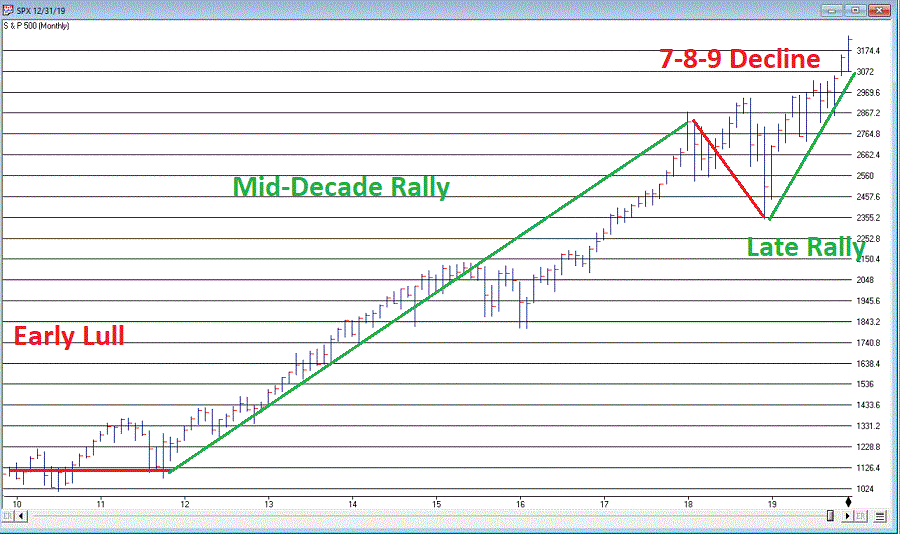OK, so this particular piece clearly does NOT qualify as “timely”. Hey, they can’t all be “time critical, table-pounding, you must act now” missives. In any event, as part of a larger project regarding trends and seasonality in the market, I figured something out – we “quantitative analyst types” refer to this as “progress.”
So here goes.
The Month of October in the Stock Market
The month of October in the stock market is something of a paradox. Many investors refer to it as “Crash Month” – which is understandable given the action in 1929, 1978, 1979, 1987, 1997, 2008 and 2018. Yet others refer to it as the “Bear Killer” month since a number of bear market declines have bottomed out and/r reversed during October. Further complicating matters is that October has showed:
*A gain 61% of the time
*An average monthly gain of +0.95%
*A median monthly gain of +1.18%
Figure 1 displays the monthly price return for the S&P 500 Index during every October starting in 1945.

Figure 1 – S&P 500 Index October Monthly % +(-)
Figure 2 displays the cumulative % price gain achieved by holding the S&P 500 Index ONLY during the month of October every year starting in 1945.

Figure 2 – S&P 500 Index Cumulative October % +(-)
So, you see the paradox. To simply sit out the market every October means giving up a fair amount of return over time (not to mention the logistical and tax implications of “selling everything” on Sep 30 and buying back in on Oct 31). At the same time, October can be a helluva scary place to be from time to time.
One Possible Solution – The Decennial Pattern
In my book “Seasonal Stock Market Trends” I have a section that talks about the action of the stock market across the average decade. The first year (ex., 2010) is Year “0”, the second year (ex., 2011) is Year “1”, etc.
In a nutshell, there tends to be:
The Early Lull: Often there is weakness starting in Year “0” into mid Year “2”
The Mid-Decade Rally: Particularly strong during late Year “4” into early Year “6”
The 7-8-9 Decline: Often there is a significant pullback somewhere in the during Years “7” or “8” or “9”
The Late Rally: Decades often end with great strength
Figures 3 and 4 display this pattern over the past two decades.

Figure 3 – Decennial Pattern: 2010-2019

Figure 4 – Decennial Pattern: 2000-2009
Focusing on October
So now let’s look at October performance based on the Year of the Decade. The results appear in Figure 5. To be clear, Year 0 cumulates the October % +(-) for the S&P 500 Index during 1950, 1960, 1970, etc. Year 9 cumulates the October % +(-) for the S&P 500 index during 1949, 1959, 1969, 1979, etc.

Figure 5 – October S&P 500 Index cumulative % +(-) by Year of Decade
What we see is that – apparently – much of the “7-8-9 Decline” takes place in October, as Years “7” and “8” of the decade are the only ones that show a net loss for October.
Let’s highlight this another way. Figure 6 displays the cumulative % return for the S&P 500 Index during October during all years EXCEPT those ending “7” or “8” versus the cumulative % return for the S&P 500 Index during October during ONLY years ending in “7” or “8”.

Figure 6 – S&P 500 cumulative October % +(-); Years 7 and 8 of decade versus All Other Years of Decade
For the record:
*October during Years “7” and “8” lost -39%
*October during all other Years gained +196%
Summary
So, does this mean that October is now “green-lighted” as bullish until 2027? Not necessarily. As always, that pesky “past performance is no guarantee of future results” phrase looms large.
But for an investor looking to maximize long-term profits while also attempting to avoid potential pain along the way, the October 7-8 pattern is something to file away for future reference.
Jay Kaeppel
Disclaimer: The information, opinions and ideas expressed herein are for informational and educational purposes only and are based on research conducted and presented solely by the author. The information presented does not represent the views of the author only and does not constitute a complete description of any investment service. In addition, nothing presented herein should be construed as investment advice, as an advertisement or offering of investment advisory services, or as an offer to sell or a solicitation to buy any security. The data presented herein were obtained from various third-party sources. While the data is believed to be reliable, no representation is made as to, and no responsibility, warranty or liability is accepted for the accuracy or completeness of such information. International investments are subject to additional risks such as currency fluctuations, political instability and the potential for illiquid markets. Past performance is no guarantee of future results. There is risk of loss in all trading. Back tested performance does not represent actual performance and should not be interpreted as an indication of such performance. Also, back tested performance results have certain inherent limitations and differs from actual performance because it is achieved with the benefit of hindsight.

